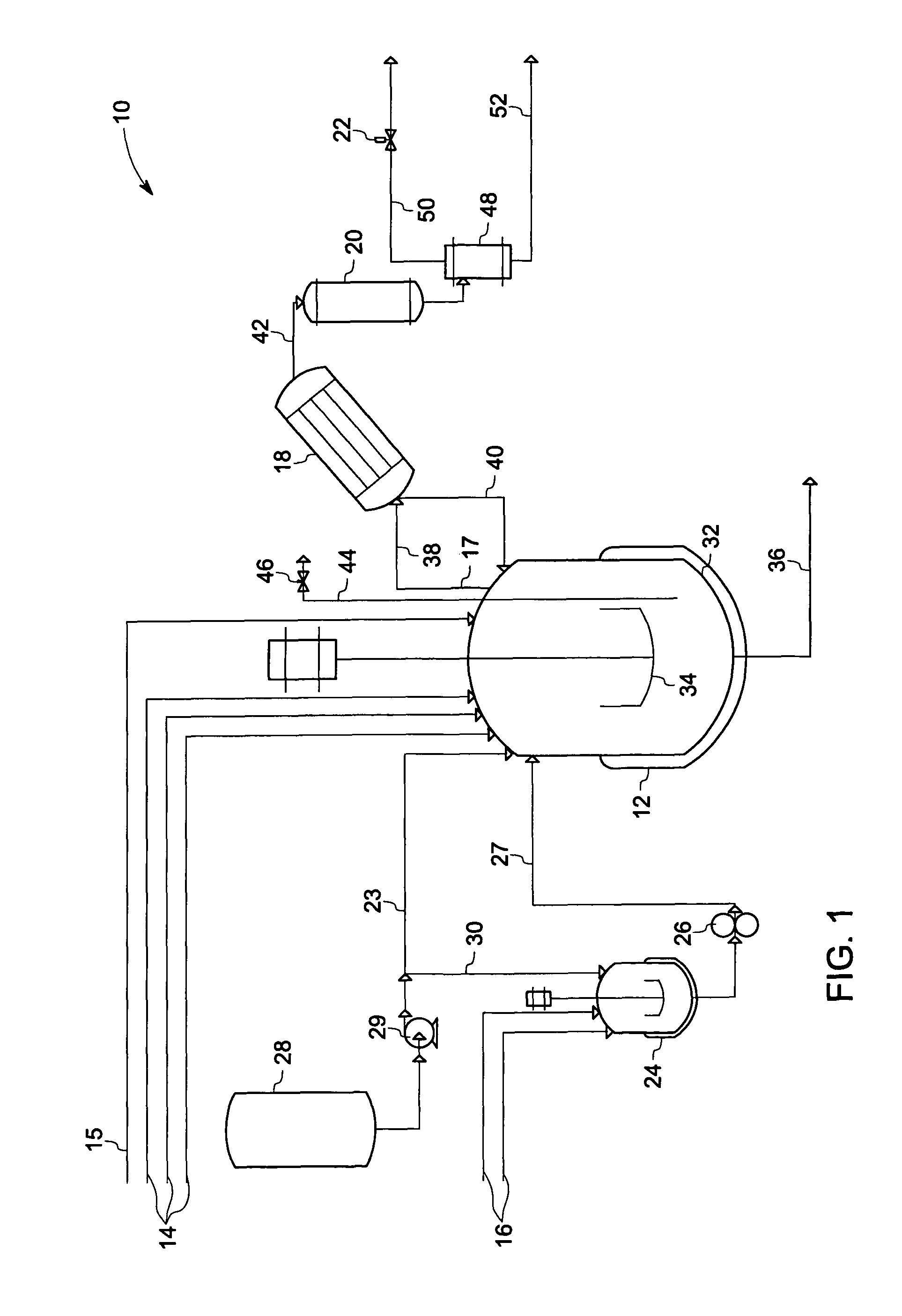Method of making bisimides
a technology of bisimides and bisimides, applied in the field of bisimides, can solve the problems of presenting significant challenges, difficult process steps, and burdensome weighing and handling
- Summary
- Abstract
- Description
- Claims
- Application Information
AI Technical Summary
Benefits of technology
Problems solved by technology
Method used
Image
Examples
example-1
Imidization in Parr Reactor with Melt CLPA Addition—Procedure:
[0066]A 450 ml Parr pressure-rated reactor equipped as in Comparative Example-1 was charged with DDS (14.898 g; 60 mmol), sodium phenylphosphinate (50 mg, 0.3 mmole) and o-DCB (85 mL). The temperature was gradually raised to about 225-230° C. The resultant homogeneous solution was maintained at about 230° C. for 1 hr after which time molten 3-chlorophthalic anhydride (3-ClPA, 21.578 g, 118.2 mmole) and phthalic anhydride (0.2664 g; 1.8 mmol) at about 130° C. was added from a stainless steel bomb mounted on top of the reactor. The addition of 3-ClPA was carried out over a period of about 30 to 40 minutes. Water of imidization was azeotropically removed from the reactor via the partial condenser. Throughout the 3-ClPA / PA addition, and thereafter, the reaction mixture was observed to remain a homogeneous solution while at 230° C. No thick phase behavior was observed during the reaction. As the reactor was cooled, the product...
example 2
[0076]The 5-gallon reactor described above and shown in FIG. 1 was equipped with 2 flights of 4-blade pitched turbines, and was charged according to Table I below.
[0077]
TABLE IComponentMass (g)MolesSource4,4 Diamino Diphenyl Sulfone1520.86.125Atul(DDS)Phthalic Anhydride (PA)27.190.184AldrichSodium Phenyl Phosphinate5.00.030Akzo(SPP)3-Chloro Phthalic Anhydride2202.812.066Pressure Chem.(ClPA)1,2 Dicholoro Benzene (ODCB)975666.37PPG Grade F
[0078]The reactor was purged with inert gas at 100 SCCM, and the agitation rate was set to 200 rpm. The partial condenser was heated by means of an oil jacket to a temperature of about 130° C. The reactor was heated by setting the reactor oil jacket temperature to 200° C. After 30-minutes of heating, the reactor oil jacket temperature was increased to 230° C. The reactor internal temperature reached a temperature of about 177° C. Water and ODCB were collected as condensed distillate. The reactor pressure was 26.3 psig. Amounts of distillate collected...
example 3
Melt 3-CLPA Semi-Batch Reaction Mode
[0082]The 5-gallon reactor described above and shown in FIG. 1 was equipped with 2 flights of 4-blade pitched turbines, and was charged according to Table III below.
[0083]
TABLE IIIComponentMass (g)MolesSource4,4 Diamino Diphenyl Sulfone1520.86.125Atul Inc.(DDS)Sodium Phenyl Phosphinate5.00.030Akzo Inc.(SPP)1,2-Dicholoro Benzene999168.0PPG Grade F(ODCB)
[0084]Heated tank 24 (FIG. 1) was charged with phthalic anhydride (PA) and 3-chlorophthalic anhydride (3-ClP) in the amounts shown in Table IV and heated to 140° C. in order to melt the 3-ClPA / PA solids. ODCB (240 grams) was then added to the molten mixture of 3-ClPA and PA which was completely miscible with the ODCB. Thus, the mixture in heated tank 24 comprised 3-ClPA (89.2 wt %), ODCB (9.7 wt %), and PA (1.1 wt %). The small amount of ODCB solvent employed helped to facilitate complete transfer of the anhydride reactants into the reaction mixture.
[0085]
TABLE IVComponentMass (g)MolesSourcePhthalic ...
PUM
| Property | Measurement | Unit |
|---|---|---|
| temperature | aaaaa | aaaaa |
| temperature | aaaaa | aaaaa |
| temperature | aaaaa | aaaaa |
Abstract
Description
Claims
Application Information
 Login to View More
Login to View More - R&D
- Intellectual Property
- Life Sciences
- Materials
- Tech Scout
- Unparalleled Data Quality
- Higher Quality Content
- 60% Fewer Hallucinations
Browse by: Latest US Patents, China's latest patents, Technical Efficacy Thesaurus, Application Domain, Technology Topic, Popular Technical Reports.
© 2025 PatSnap. All rights reserved.Legal|Privacy policy|Modern Slavery Act Transparency Statement|Sitemap|About US| Contact US: help@patsnap.com



